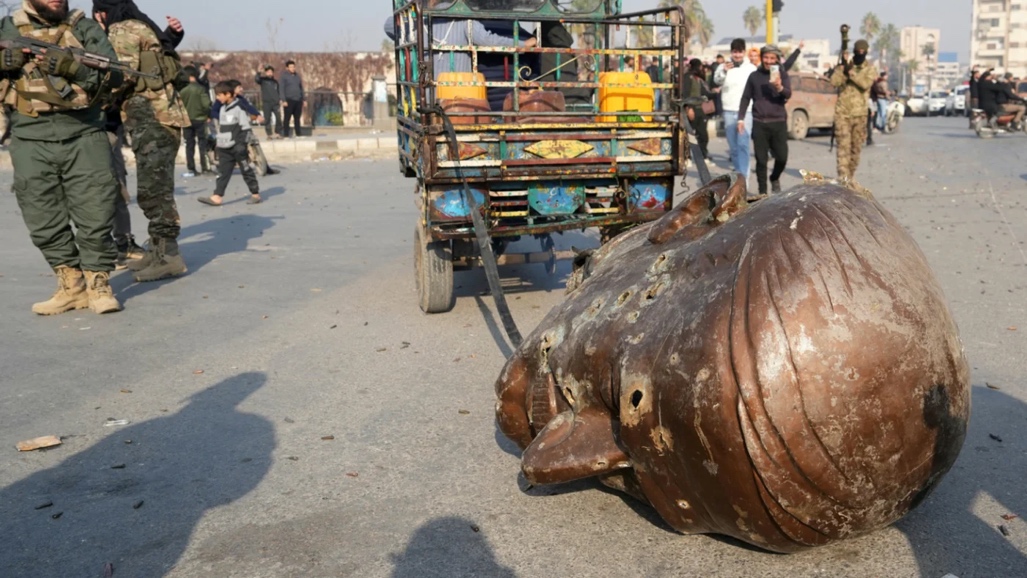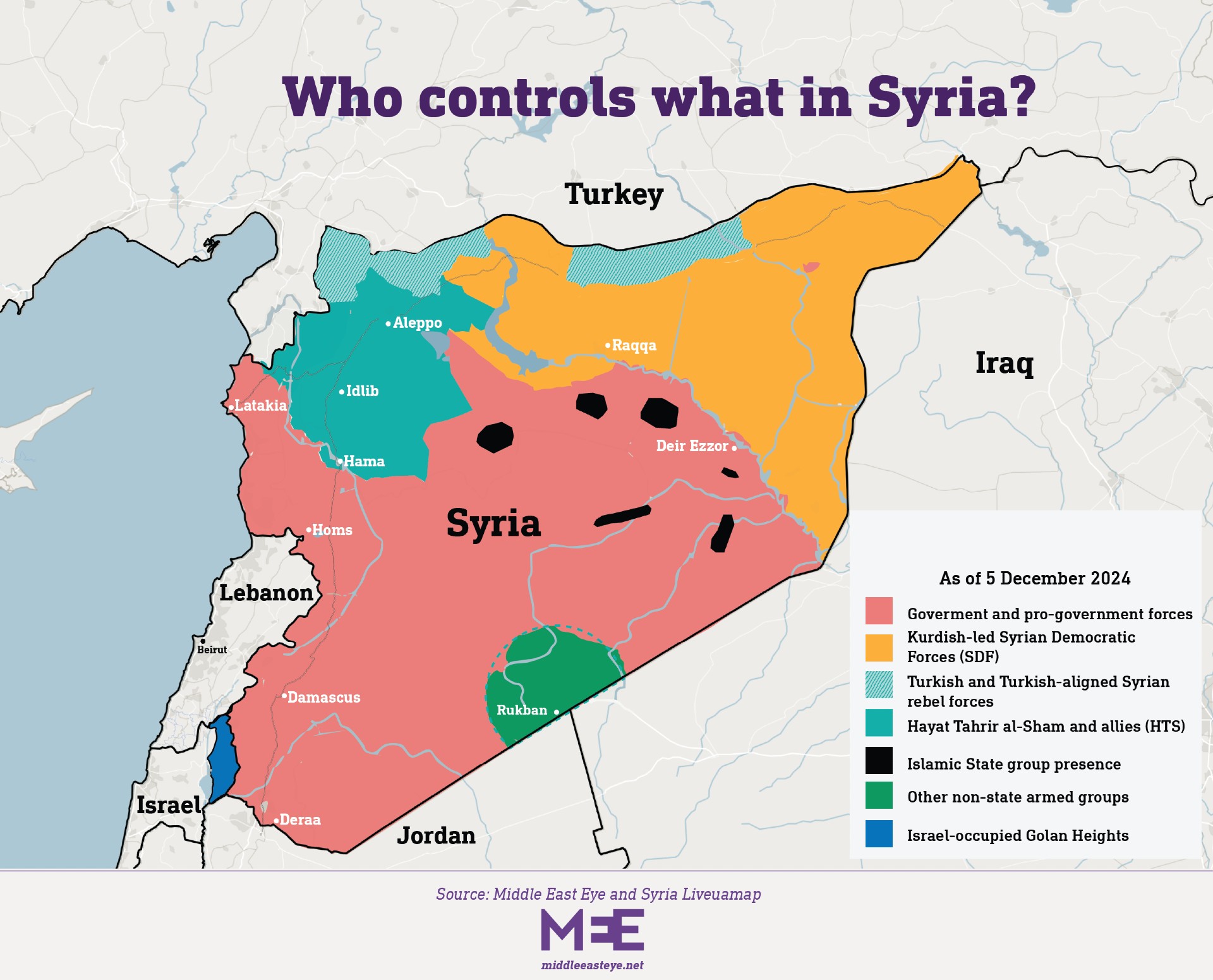https://www.middleeasteye.net/news/why-syrian-army-collapsed-so-quickly-northern-syria
Why the Syrian army collapsed so quickly in northern Syria

For four years, it seemed as if President Bashar al-Assad's army had largely won the civil war in Syria.
Regional and international actors were re-establishing ties with the Syrian government, believing the conflict to have generally wrapped up, with Syrian and Russian forces occasionally targeting rebel-held pockets in the northwest.
Travel vloggers were regularly invited to trips to Damascus, Aleppo and other areas to promote tourism while the government’s main concerns were the increasing Israeli strikes on Iranian and Hezbollah positions and figures in the country.
All that carefully balanced relative calm collapsed when the Syrian army, seemingly overwhelmed and overpowered, lost the major cities of Aleppo and Hama in a single week following a surprise rebel offensive.
While rebels have engaged in fierce fighting with government forces in some areas and encountered some resistance, their advances have been relatively smooth, capturing large swathes of land around Aleppo and Hama as Syrian government officials say they are regrouping outside the lost cities.
With the groups reportedly getting closer to the strategic city of Homs, many questions were raised over the Syrian army’s fighting capabilities, and why it has failed to fight off rebel advances.
A coalition that ‘no longer exists’
With the help of Russia, Iran, Lebanon’s Hezbollah and other groups, Assad was able to retake several key territories his government had lost during the first few years of his country’s 13-year civil war.
But with his allies diverted by other crises, as Russia fights its war in Ukraine and Hezbollah suffering heavy losses in its war with Israel, the Syrian army has found itself fighting its own battles mainly alone.
Tellingly, the rebels launched their offensive in northern Syria the same day a fragile ceasefire went into effect between Hezbollah and Israel.
“Earlier in the war, the so-called government forces were a patchwork coalition that included the army, expanded security branches recruiting additional fighters, auxiliary forces, Hezbollah, foreign pro-Iranian militias, [Iranian Revolutionary Guards Corps] advisors, and Russia’s air support,” Armenak Tokmajyan, a nonresident fellow at the Malcolm H Kerr Carnegie Middle East Center in Beirut, told Middle East Eye.
“Today, that coalition no longer exists. That’s the likely explanation for the regime's inability to withstand the opposition's advancing forces.”

Meanwhile, the Financial Times reports that rebel forces, particularly those led by Hay’at Tahrir al-Sham (HTS), seem to have been able to absorb some rival rebel factions, as well as Syrian army defectors, foreign Islamist fighters and rebels who may not share HTS’s ideology.
HTS was also able to easily procure basic weaponry, as Syria was flooded with weapon supplies over the years from Turkey and some Arab states who, with US support, initially tried to strengthen the rebels against Assad’s government.
All this happened while the Syrian government and its allies hoped the agreements made in the Kazakh capital Astana, and sponsored by Russia, Iran and Turkey, would hold firm, according to Tokmayjan.
Under UN auspices, the agreements, which consisted of indirect talks between some rebel factions and the government, aimed at reaching a political solution through de-escalation. Some criticised them as one-sided, as the government was accused of violating the terms on several occasions while hoping the talks would continue.
“They were wrong,” said Tokmayjan. “On the ground, the simple reality was that the regime lacked the necessary fighting capacity, compounded by minimal support from its allies.”
Organised groups, drone warfare
Following his troops’ withdrawal from Hama, Syrian Defence Minister Ali Mahmoud Abbas said that, “what happened in Hama today is a temporary tactical measure and our forces are still around the city”.
Abbas said rebel forces are trying to spread “chaos and misinformation” on the situation on the ground and warned citizens against believing them.
Despite this, footage from Homs showed highways packed with cars leaving for Syria’s coastal cities, as people believe the rebels may be close to taking the city.
“The army’s collapse is a reflection of a more general collapse in Syrian state institutions,” said Jihad Yazigi, editor-in-chief of the Syria Report.
Syria’s years-long economic crisis, increased repression and continued instability may have contributed to a general lack of morale and organisation in government-held areas.
“There is a deep sense in regime areas that things are not only not improving, but that there are no prospects of things getting better,” Yazigi added.
Amidst the chaos unfolding on the battlefield, Assad said he will hike the salaries of active-duty soldiers by 50 percent in what experts believe is an attempt to boost army morale.
“It is clear that the collapse in army morale is something well seen and understood for anyone watching Syria,” said Yazigi.
Tokmayjan said that, in contrast, “the HTS-led coalition seems to be well-organised and prepared”.
The group has even deployed some locally manufactured drones, which may have contributed in tipping the scale of the battle in their favour.
Heiko Wimmen, project director for Iraq, Syria and Lebanon at the Crisis Group, said that the Syrian army may have not been prepared for this kind of “warfare and innovations” used by the rebels.
“Conventional armies that are not used to that, then confronted with this, fare very badly at the beginning at least,” he said.
Despite seeming efforts from the Syrian government to reorganise, and hints from its ally Hezbollah that it will “stand by it” to stave off the rebel advances, experts say the difficulties its army faces leaves the future uncertain.
“The signals are far from reassuring for Assad and the regime in Damascus,” said Tokmayjan.